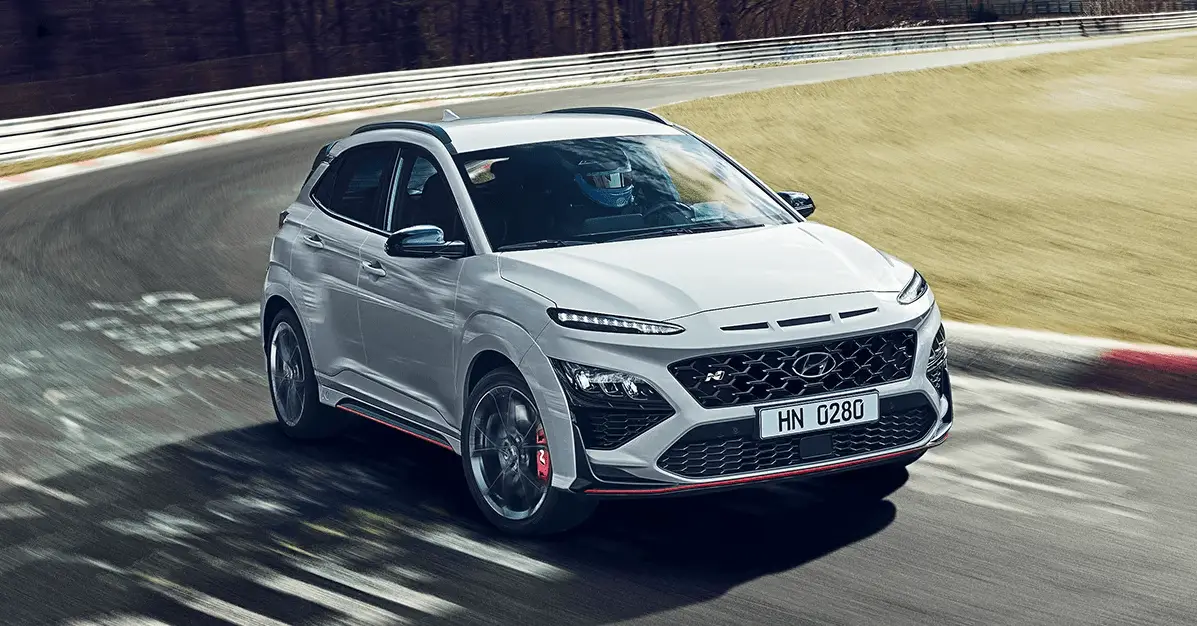Hyundai Kona-N 2023 Brake Fluid and Washer Fluid
The simplicity and comfort of its washer fluid and air conditioning systems are just two examples of the many small elements that the 2023 Hyundai Kona-N takes great delight in paying close attention to. With the correct windscreen washer fluid and an easy-to-use washer fluid reservoir, owners can easily maintain maximum visibility. Beyond only controlling the temperature, the cabin’s air conditioning system offers features like air filtration for better air quality and the option for dual-zone climate control to accommodate personal preferences. The washer fluid and air conditioning systems of the 2023 Hyundai Kona-N excel in providing a seamless and delightful driving experience, whether it’s maintaining a clear view of the road or generating a comfortable inside environment.
2023 HYUNDAI KONA Specs, Price, Features, Milage (brochure)
Brake Fluid
Checking the Brake Fluid Level

Check the fluid level in the reservoir periodically. The fluid level should be between MAX and MIN marks on the side of the reservoir. Before removing the reservoir cap and adding brake fluid, clean the area around the reservoir cap thoroughly to prevent brake fluid contamination. If the level is low, add the specified brake fluid to the MAX level. The level will fall with accumulated mileage. This is a normal condition associated with the wear of the brake linings. If the fluid level is excessively low, have the brake system checked by an authorized HYUNDAI dealer.
WARNING
If the brake system requires frequent additions of fluid this could indicate a leak in the brake system. Have the vehicle inspected by an authorized HYUNDAI dealer.
WARNING
Do not let brake fluid enter into your eyes. If brake fluid gets in your eyes, flush your eyes with clean water for at least 15 minutes and get immediate medical attention.
NOTICE
- Do not allow brake fluid to contact the vehicle’s body paint, as it will result in paint damage.
- NEVER use brake fluid that has been exposed to open air for an extended time, as its quality cannot be guaranteed. It should be disposed of properly.
- Do not use the wrong type of brake fluid. A few drops of mineral-based oil, such as engine oil in your brake system can damage brake system parts.
Information
Use only the specified brake fluid (refer to the “Recommended Lubricants and Capacities” section in Chapter 2).
WASHER FLUID
Checking the Washer Fluid Level
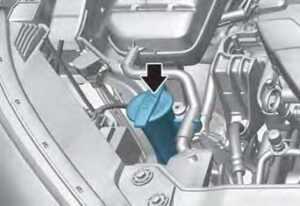
Check the fluid level in the washer fluid reservoir and add fluid if necessary. Plain water may be used if washer fluid is not available. However, use a washer solvent with antifreeze characteristics in cold climates to prevent freezing.
WARNING
To prevent serious injury or death, take the following safety precautions when using washer fluid:
- Do not use engine coolant or antifreeze in the washer fluid reservoir. Engine coolant can severely obscure visibility when sprayed on the windshield and
may cause loss of vehicle control resulting in an accident or damage to paint and body trim. - Do not allow sparks or flame to contact the washer fluid or the washer fluid reservoir. Washer fluid may contain alcohol and can be flammable.
- Do not drink washer fluid and avoid contact with the skin. Washer fluid is harmful to humans and animals.
- Keep washer fluid away from children and animals.
Parking Brake,
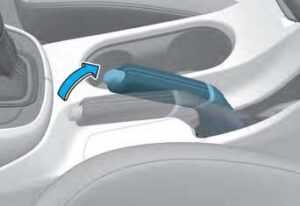
Check the stroke of the parking brake by counting the number of “clicks” heard while fully applying it from the released position. Also, the parking brake alone should securely hold the vehicle on a fairly steep grade. If the stroke is more or less than specified, have the parking brake adjusted by an authorized HYUNDAI dealer. Stroke: 4~6 clicks at a force of 44 lbs (20 kg, 196 N)
AIR CLEANER
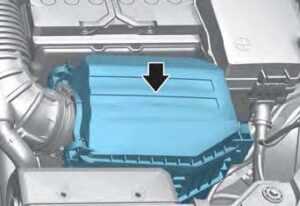
The air cleaner filter can be cleaned for inspection using compressed air. Do not attempt to wash or rinse it, as water will damage the filter. If soiled, the air cleaner filter must be replaced.
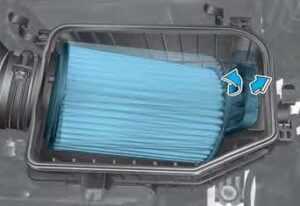
- Loosen the air cleaner cover by attaching clips and open the cover.
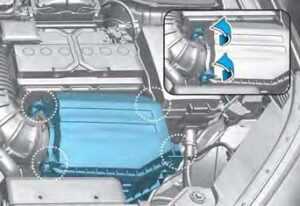
- Wipe the inside of the air cleaner.
- Replace the air cleaner filter.
- Lock the cover with the cover attaching clips.
- Check that the cover is firmly installed.
Information
If the vehicle is operated in extremely dusty or sandy areas, replace the element more often than the usual recommended intervals (refer to “Maintenance Under Severe Usage Conditions” in this chapter)..
NOTICE
- Do not drive with the air cleaner filter removed. This will result in excessive engine wear.
- When removing the air cleaner filter, be careful that dust or dirt does not enter the air intake, or damage may result.
- Use HYUNDAI genuine parts. The use of non-genuine parts could damage the airflow sensor.
CLIMATE CONTROL AIR FILTER
Filter Inspection
Replace the filter according to the Maintenance Schedule. If the vehicle is operated in severely air-polluted cities or on dusty rough roads for a long period, it should be inspected more frequently and replaced earlier. When you, the owner, replace the climate control air filter, replace it performing the following procedure, and be careful to avoid damaging other components.
Filter Replacement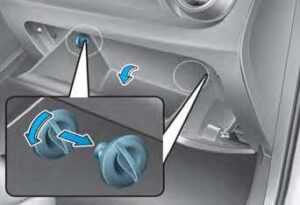
- With the glove box open, remove the stoppers on both sides.
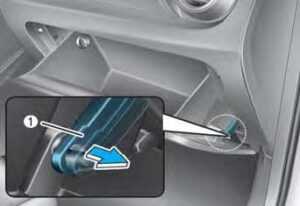
- Remove the support strap (1).

- Remove the climate control air filter case while pressing the lock on the right side of the cover.

- Replace the climate control air filter.
- Reassemble in the reverse order of disassembly.
NOTICE
Install a new climate control air filter in the correct direction otherwise, it may be noisy and the effectiveness of the filter may be reduced.
FAQ
It’s recommended to use a windshield washer fluid that is suitable for all-season use and provides good cleaning and freeze protection.
Open the hood, locate the washer fluid reservoir, remove the cap, and pour the washer fluid carefully into the reservoir until it reaches the appropriate level.
Avoid spilling washer fluid on the vehicle’s paint, as it can cause streaks or damage. Use a funnel for precise pouring.
While water can be used temporarily in emergencies, it’s not recommended for long-term use, especially in cold weather, as it may freeze and damage the system.
Many modern vehicles, including the Kona-N, have a warning light on the dashboard that illuminates when washer fluid is low.
Cabin air filters should typically be replaced every 15,000 to 30,000 miles, but it’s a good practice to check the owner’s manual for the manufacturer’s recommendations.
The cabin air filter helps remove dust, pollen, and other airborne particles from the air entering the vehicle’s cabin, improving air quality.
The cabin air filter can be replaced by accessing it through the glove compartment or the firewall area, depending on the vehicle’s design. Consult the owner’s manual for specific instructions.
The availability of a dual-zone climate control system may vary by trim level. Some versions of the Kona-N offer this feature for personalized comfort in the front seats.
The availability of rear-seat climate control also depends on the trim level and options chosen.
Yes, the climate control system typically allows you to adjust these parameters to customize your comfort.
Heated seats are often available in the Kona-N, but the availability of ventilated seats may vary by trim level.
Yes, the Kona-N typically includes front and rear window defrosters to improve visibility in cold weather.
Some models may offer the ability to remotely start and precondition the cabin using the vehicle’s key fob or a mobile app.
The Kona-N may include air quality sensors and advanced filtration systems to improve the quality of the air inside the cabin.
Useful Link
View Full User Guide: Hyundai Kona-N 2023 User Guide
Download Manuals: https://owners.hyundaiusa.com/us/en/resources/manuals-warranties.html
2023 HYUNDAI KONA Specs, Price, Features, Milage (brochure)

